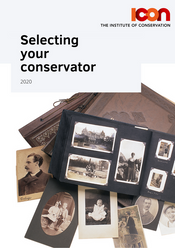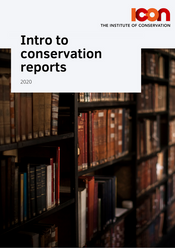Choosing the right conservator to look after a collection or an item is an important decision; the wrong choice could result in permanent damage or loss.
We can help you understand what to expect when hiring a professionally qualified conservator. Click through the sections below to learn about the key issues to bear in mind when selecting a professional. You can also download our free factsheets on Selecting a Conservator and Understanding Conservation Reports.
10 steps to selecting and working with a conservator
- Outline your requirements and ambitions for the work.
- Search for conservators on the Conservation Register.
- Contact a possible conservator with relevant experience.
- Meet with the conservator-restorer in the presence of the object to enable the conservator to prepare a treatment proposal and quotation.
- Decide on most suitable candidate taking into account factors such as experience (supported by references), cost and availability.
- Ensure that the conservator has appropriate security arrangements and insurance cover in place.
- Agree a written contract including timeframes.
- Keep in contact with the conservator once work commenced.
- On completion of the project ensure that all work has been fully documented in the ‘Project Report’.
- Pay the conservator’s final invoice once the final Project Report has been received.
Selecting a conservator
Whether it's your first time selecting a conservator or you're a seasoned commissioner of conservation work, the Conservation Register is the most reliable way to find a conservator you can trust. Experience, availability and cost are important factors to consider when choosing who you hire.
The brief
Depending on the extent of the work required, you may have produced a short brief or a detailed document. Decide whether to approach a single Conservator, or request quotations from a number of Conservators.
Experience and accreditation
Look for evidence of appropriate training and experience. In addition to the initial training, a Conservator may be Accredited by Icon. This means that they are subject to regular professional development reviews and assessed by their Accredited peers to verify that they are keeping in touch with the latest techniques and advances in the sector.
To find out if they're Accredited, search for them by name on the Conservation Register.
Things to consider
A written contract outlining timeframes, scope of work, geographical limitations and other details is vital to ensuring you and your conservator are on the same page.
Scope of work
Contracts
The Contract (or ‘Work Order’) document should include a basic description of the treatment plan and expected start and finish dates plus any other relevant terms and conditions. The cost quoted should be broken down and VAT clearly shown. The payment structure will differ depending on the Conservator and the value of the work to be carried out. It is usual to pay a deposit at the outset of the work with additional payments made at specific stages or upon completion of the work. The value of work should also be stated. Conservator usually know a lot about the history and composition of objects and may be able to advise you on the significance of the object, but for a valuation you should consult an auction house or a valuation expert. The Conservator may request to see proof of ownership documentation.
Where items are being treated off site you may wish to view the treatment in progress by prior arrangement with the Conservator. On occasions you may be contacted during treatment for example if the Conservator has uncovered something particularly interesting or unexpected during the course of the work or where a Conservator decides during treatment that changes should be made to their initial treatment proposal.
Place of treatment
Conservators work in a variety of locations and conditions. However, the workspace should always be self-contained and fitted out for the purpose. Does the workspace appear well-ordered, with careful handling and storage of the objects undergoing or awaiting conservation? Does the Conservator operate within current health and safety legislation and guidelines? (For example, you could look for toxic fume extraction apparatus. Does the Conservator have an emergency response plan in case of fire, flood or building damage? Do they operate in a professional and efficient fashion?
If the agreed work is undertaken on the Conservator's premises, the Conservator shall be responsible for the risk of damage to or loss of the Item whilst in the Conservator’s custody. However, the Client shall be responsible for arranging transit of the Item to and from the Conservator’s premises unless otherwise agreed in writing and the Client shall be responsible for the insurance of the Item whilst in transit. If the agreed work is undertaken on the Client's premises, then (a) the Conservator shall be responsible for any loss or damage to the Item caused as a result of the Conservator's negligence, or (b) in all other circumstances the Client shall be responsible for any loss or damage to the Item and shall take all necessary steps to insure the Item.
Record keeping
Documentation
Upon completion of treatment, you should expect to receive a conservation report.
Purposes
Conservation reports are used by conservators to record their investigations of items for which conservation is sought and to inform treatment proposals. During the preparation of a report a conservator will assess the object and its needs, and put forward advice on the steps that can be taken to ensure its conservation and future well being.
The type of report required and the amount of information to be gathered will depend largely on the needs of the client. As the client, you need to be clear about the level of information you require in a report and, if appropriate, the purpose for which it is to be used. For example, some bodies such as the National Lottery Heritage Fund or The Church of England may require a report as a precursor to agreeing funding. These reports tend to be detailed and specific guidelines are often published by the relevant body.
The preparation of a report can be time consuming and you should establish whether the conservator will make a charge for this process.
Report types
Preliminary report - As the name suggests, a preliminary report is carried out before any conservation work is started. It will describe and, as far as possible, identify damage and causes of deterioration; it will inform the treatment proposal(s) and will ultimately guide the estimate or quotation given for work to be carried out.
Interim report - An interim report may be required at one or more stages in a larger project and may act as a trigger for subsequent phases of work. The need for interim reports should be identified at the outset as part of the overall project plan.
Final report - A final report is provided on completion of conservation work. It will normally include a description of the item prior to conservation, a record of treatment carried out and will normally include a photographic record of the item before, during and after conservation.
Condition report - Condition reports will form part of preliminary/interim/final reports, or they may be commissioned as distinct pieces of work to describe the condition of an item at a particular point in time (but not making recommendations for treatment) e.g. recording the condition of an item prior to it going on loan.
Report contents
As basic guidance, reports will commonly include the types of information listed below.![]() However, not all of these elements will be appropriate for every conservation project. Your initial discussions with the conservator will provide guidance on which aspects are relevant to the project with which you are involved. Some bodies, such as The Church of England - Cathedral and Church Buildings Division have produced individual guidelines on the information that it requires to accompany faculty and grant applications.
However, not all of these elements will be appropriate for every conservation project. Your initial discussions with the conservator will provide guidance on which aspects are relevant to the project with which you are involved. Some bodies, such as The Church of England - Cathedral and Church Buildings Division have produced individual guidelines on the information that it requires to accompany faculty and grant applications.
After completion
Resources


